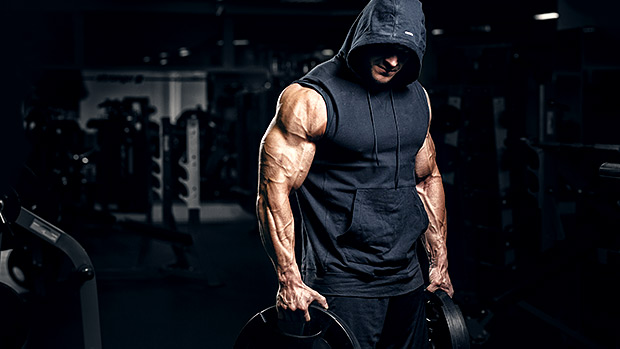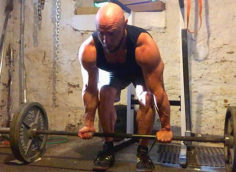Remember those "Eat This, Not That!" books? They were basically a guideline to help people make better food choices.
"Don't eat that whole Bloomin' Onion from Outback. Eat this apple instead."
Okay, so that was never a comparison, but you get the point. With weight training you've probably accumulated a few of your own "do this, not that" guidelines over the years. But here are three of mine that'll help you get better results and lower your risk of injury.
Do This: Allow the shoulders to rotate around the ribcage.
It's the job of the anterior serratus to help pull the shoulders forward. Yes, "protraction" is usually the term tossed out, but in this case we're just wanting them to rotate around the rib cage so that the pecs can get fully shortened. It's the shortening of the serratus that actually hugs the shoulders in close to the rib cage, creating stability for the shoulders.
The scapula and humerus work in concert, and your mind shouldn't be on trying to manipulate scapula movement during chest pressing. It should be on getting maximal output from your pecs.
On the eccentric or lowering portion of the press, allow retraction to happen naturally as it should. During the concentric or lifting portion of the press, simply think about getting your armpits into the center of your chest.
That means your shoulders should roll around naturally (not into protraction) as they were designed to do when you're trying to get your pecs to function. This is the way your body was designed to move. You're not smarter than your anatomy.
Do your chest pressing and flye movements this way for better pec development. Yes, that includes doing it like this on the bench press too if you're benching for pec development.
Not That: Lock it down.
The "lock it down" advice is usually in reference to locking a joint down during an exercise to facilitate either more isolation of a muscle, or (theoretically) to create more stability for a joint.
In the case of chest pressing, or chest exercises in general, locking the scapula down into retraction is what's most common here. And doing this doesn't create more output by the pecs, or more stability for the shoulders.
In fact, locking your scapula down into retraction and holding it there actually keeps the pecs from maximally contracting. It creates a less stable joint from which to press.
When you hold the scapula in retraction as you press, it keeps the anterior serratus from being able to do its job and keeps the pecs from fully shortening. You're not actually getting the pecs to work maximally, and you're not actually creating the stability that powerlifting junkies say you are.
I mean, does powerlifting seem like the bastion of great shoulder and pec health to you?
The mechanics preached in the powerlifting bench press (pack the shoulders, hold them there) is done to reduce the range of motion so that the lifter can move the greatest amount of weight. That's it.
It's not safer or more stable. It does not maximally work the pecs. In fact, it doesn't work the pecs at all. I dare you to try and get a maximal pec contraction while holding your shoulders in retraction the whole time. You literally won't be able to do it. It's not my opinion, it's anatomical fact.
Do This: Maximize hip flexion with a neutral spine.
If you're trying to use the squat as an actual booty builder, you'll want to do these things...
- Get the greatest amount of hip flexion without going into posterior pelvic tilt.
- Keep a neutral spine; don't arch at the low back and don't allow it to tuck under or round out.
- Allow the bar and hips to move away from one another creating a longer moment arm for the glutes to work against.
- Pause squats are probably a good idea here to give the glutes more time under tension as well.
Let's address these a bit to make this picture clearer.
Effectively loading the glutes in a squat isn't about how deep you're squatting. It's about getting maximal hip flexion while avoiding posterior pelvic tilt.
If posterior pelvic tilt happens, then despite your coach telling you it's not a big deal, you just lost tension in the glutes and distributed tension onto the lumbar spine and erectors. Does that sound like a good idea?
Now let's deal with physics. A longer moment arm from the hips to the resistance means the glutes are going to end up doing the brunt of the work (to overcome that longer moment arm).
When your focus is on the greatest amount of hip flexion, you will by default reduce the degree of knee flexion, which is more of a quad bias. Now we're loading the glutes more effectively, and we're not using shitty cues like "corkscrew the feet" which does nothing to activate or load them.
"So that means lean forward more, right?"
No, it doesn't. It means to focus on a deeper hinge in the squat, and only to the point where you don't go into posterior pelvic tilt at the bottom, while keeping a neutral spine.
Some people may lean a little more forward than others simply due to their levers. And most certainly, it's going to create a longer lever arm from the barbell to the hips, but that's also something we want as well. Because now the hips have to work harder against the resistance, meaning there's more tension on them, meaning they're more mechanically loaded. This leads to more growth.
To maximize hip flexion and create a longer lever arm from the weight to the hips, you'll probably have to "push the knees out" abducting the hips. This will allow your greatest degree of hip flexion in the descent of the squat, and should naturally put the bar further away from the hips.
This means you'll need to point your toes out as well. How much? You'll want your knees to track over them so that when you push them out, they're in line with your feet throughout the entire movement.
Once you get this down, simply avoid going so deep that you find yourself going into posterior pelvic tilt. If you're nailing the above, that shouldn't actually happen. And now you can actually use the squat as a pretty good booty builder.
Not That: Screw your feet into the floor.
A fairly common cue from coaches to get more glute activation with squats is to think about corkscrewing your feet into the floor during the concentric. Why? Because the glutes do maximally contract and shorten when there's external hip rotation. But only when the foot is free to move, like in stride mechanics.
Yeah, stride mechanics. Like running. Not when your feet are permanently fixed to the floor in a closed-chain movement.
You can't just use coloring book anatomy here and say "the glute maximus is responsible for external hip rotation" and leave it at that. Context of movement matters.
When your feet are locked into position, like in a squat, deadlift, or hip thrust, corkscrewing the feet does not help to further shorten the glutes. And that strong contraction you think you’re feeling in the glutes? It's simply the deep external rotators of the femur, like the piriformis and a bunch of others that sound like names from Star Trek.
"But when I corkscrew like that I swear I feel my glutes!"
I'm sure it does feel like your glutes since you're creating this massive amount of torque at the hip joint by trying to rotate the feet out isometrically against the immovable floor. But it's not your glutes you're feeling contract. It's those deep internal hip rotators I mentioned above.
Do This: Work within your mobile and active range.
If you have someone take a photo of you from the side in a vertical seated position as you're about to press, most likely you'll see that you're starting the press from an internally-rotated position.
But if you lean the seat back there will be a point where the joints become stacked and in line with the resistance they're pressing against. This is the best position to press from since it's your natural active range that isn't putting undo stress on the passive structures.

This works for basically all seated press variations. If you're in a machine press, simply slide your butt forward until your wrists, elbows, and shoulders are lined up with the handles on the machine. If you're using an incline bench, set it at an angle where your joints are stacked and in line with the resistance.
People who do this feel immediate relief in their shoulders when overhead pressing. So if your shoulders have been giving you problems, this could be a very simple fix that cures your woes and helps you build bigger delts.
Not That: Overhead press sitting straight up.
What's the problem with pressing straight up while standing up? Well, let's say you're just wanting to build some delts. If you're doing standing presses because you think it's more manly than "sitting down" then I can tell you that the guy sitting down is going to build bigger delts than you. But I digress.
When most lifters set up to do seated dumbbell, barbell, or machine presses, they find a seat that's completely vertical. And this isn't always a problem... if you actually have the shoulder mobility to press from that position.
But most lifters are far too internally rotated to press overhead like that and keep their joints stacked from wrists to elbows to shoulders to the resistance. And this joint stacking is the most effective way to overload the target muscle, and to make sure you're not putting the joints in a compromised position and loading the soft tissues or more fragile muscles.





